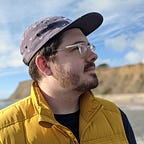HV Weekly Journal 4
Solar systems, planets, & starting from scratch
Each week, I’ll post something akin to a personal journal entry that gives an overview of what I did for that week. These posts will provide less-polished insights, keep me focused on producing material, and will allow for earlier feedback. Let’s jump in.
This journal is for week six.
A while back, I heard about a project called SpaceVR. The group is working to get a satellite into orbit with a spherical camera system on it. At first I thought whoop-dee-doo. Then I heard the founder describe the experience astronauts have when they see Earth from space: humbling with an increased desire to work towards peace and sustainability. You can hear the same sentiments after the Pale Blue Dot image came out. SpaceVR wants to bring this experience, though a more immersive version, to young students. Maybe our future will be a little brighter if we start with the realization of our cosmic loneliness.
Inspired by this, I wanted to create a prototype of the experience. Creating a model solar system seemed to be a good place to start. I rigged up a model with a sun and a few orbiters before I looked for real data.
Wikipedia helped me find orbital speeds, orbital radii, and planetary sizes. I took all of that, threw it into some HTML tags in A-Frame, and used a JS function to construct the rest of the model for me.
I don’t know why I didn’t think about it, but planets are really far away. Like, real far. So far that either A-Frame won’t render it because of the distance away from the camera or because a planet won’t take up enough space to register a full pixel of color.
Tiny planets are not what I’m going for.
So, I created scaling parameters to help keep everything visible. I tweaked my model and the parameters until I was generally satisfied with the presentation.
But, a scaled model of the solar system also isn’t what I’m going for.
Originally, I thought I could make a full model, then throw a camera anywhere I wanted. But as I was building the prototype, I lost sight of my vision (not to mention that A-Frame also breaks the rotation attribute of an element when you put a camera inside of it). I’m not trying to create a generalized model of our solar system — the goal is to create a view from just above Earth. I was building for the wrong level of complexity. That’s a prototype no no.
Back to the drawing board.
This time, I created my model in under two hours. I knew what I wanted to make and went full force into it. Found an equirectangular representation of the Milky Way and one of the Earth’s surface #ThanksNASA. Put it together in A-Frame, spun the Earth, added mostly-transparent spheres to fake the Earth’s atmosphere, and I was done.
More in the upcoming case study.
The A-Frame Editor beta was released this week and I was so excited. But then when I tried to add it into my own project, it failed for each method I tried. Maybe another week.
Also, with my limited time in the example editor, the UX seems a bit off. Maybe it is because it is in the browser, it’s still in beta, or the inherent complexity of building worlds, but I had some struggles navigating it.
This weekend I’ll work on my write ups for my experiments and finish off some user testing. Time to start publishing these case studies!
User testing generally requires some degree of privacy. As a researcher, you can help make your participants feel comfortable in the session. If you’re out in a public space, participants may feel more performance anxiety. There are ways to combat that for traditional screen based interfaces, but wearing a box over your eyes while you twirl around isn’t going to make participants feel comfortable in public.
I had been planing to do some user testing at the local restaurant my girlfriend manages/chefs/juices at. Not doing that now that my brain caught up with itself.
In other news, I updated the presentation of my prototype page.
Reading & Media
Physical and Alternative Reality Narratives (PARN)
As I try to figure out how to build volumetric applications and interactions, it’s useful to read about other, similar work. Physical narratives are just that. (Also, you can think about physical narratives as installation-ish pieces with a story the audience explores.) PARN’s learnings are VR’s learnings. You have to figure out how to guide a participant’s attention in a physical narrative just like you have to in a virtual reality narrative. The first chapter What is a Physical Narrative? was the most helpful to my work thus far.
Studio 360 in The New Yorker
In the same theme as PARN, the Studio 360 article in The New Yorker reminded me of the ties between immersive theater and VR as well as the new challenges facing cinematography when it’s put into spheres.
Until next sprint,
Andrew
